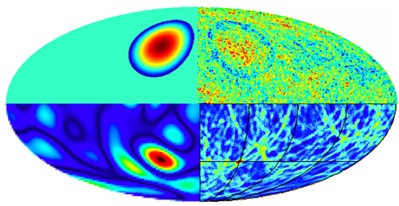
The signatures of a bubble collision at various stages in the analysis pipeline. A collision (top left) induces a temperature modulation in the CMB temperature map (top right). The ‘blob’ associated with the collision is identified by a large needlet response (bottom left), and the presence of an edge is highlighted by a large response from the edge detection algorithm (bottom right). In parallel with the edge-detection step, we perform a Bayesian parameter estimation and model selection analysis. Credit: Feeney et al. (2011)
Stephen Feeney and Hiranya Peiris, with collaborators Matt Johnson (Perimeter Institute, Canada) and Daniel Mortlock (Imperial College London) have put the theory that our universe is contained inside a bubble, and that multiple alternative universes exist inside their own bubbles – making up the ‘multiverse’ – to the test for the first time.
Many modern theories of fundamental physics predict that our universe is contained inside a bubble. In addition to our bubble, this ‘multiverse’ will contain others, each of which can be thought of as containing a universe. In the other ‘pocket universes’ the fundamental constants, and even the basic laws of nature, might be different.
Until now, there had been no way to efficiently search for signs of bubble universe collisions in the CMB radiation, as the disc-like patterns in the radiation could be located anywhere in the sky. Additionally, we needed to be able to test whether any patterns we detected were the result of collisions or just random patterns in the noisy data.
Our team ran simulations of what the sky would look like with and without cosmic collisions and developed a ground-breaking algorithm to determine which fit better with the wealth of CMB data from NASA’s Wilkinson Microwave Anisotropy Probe (WMAP). We used this algorithm to put the first observational upper limit on how many bubble collision signatures there could be in the CMB sky.
One of many dilemmas facing physicists is that humans are very good at cherry-picking patterns in the data that may just be coincidence. However, our algorithm is much harder to fool, imposing very strict rules on whether the data fits a pattern or whether the pattern is down to chance.
These first results are not conclusive enough either to rule out the multiverse or to definitively detect the imprint of a bubble collision. However, WMAP is not the last word: new data currently coming in from the European Space Agency’s Planck satellite should help solve the puzzle.
